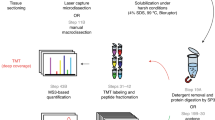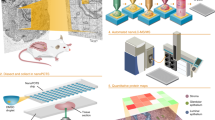Abstract
Molecular profiling of human biopsies and surgical specimens is frequently complicated by their inherent biological heterogeneity and by the need to conserve tissue for clinical diagnosis. We have developed a set of novel 'tissue print' and 'print-phoresis' technologies to facilitate tissue and tumor-marker profiling under these circumstances. Tissue printing transfers cells and extracellular matrix components from a tissue surface onto nitrocellulose membranes, generating a two-dimensional anatomical image on which molecular markers can be visualized by specific protein and RNA- and DNA-detection techniques. Print-phoresis is a complementary new electrophoresis method in which thin strips from the print are subjected to polyacrylamide gel electrophoresis, providing a straightforward interface between the tissue-print image and gel-based proteomic techniques. Here we have utilized these technologies to identify and characterize markers of tumor invasion of the prostate capsule, an event generally not apparent to the naked eye that may result in tumor at the surgical margins ('positive margins'). We have also shown that tissue-print technologies can provide a general platform for the generation of marker maps that can be superimposed directly onto histopathological and radiological images, permitting molecular identification and classification of individual malignant lesions.
This is a preview of subscription content, access via your institution
Access options
Subscribe to this journal
Receive 12 print issues and online access
$209.00 per year
only $17.42 per issue
Buy this article
- Purchase on Springer Link
- Instant access to full article PDF
Prices may be subject to local taxes which are calculated during checkout




Similar content being viewed by others
References
Issaq, H.J., Veenstra, T.D., Conrads, T.P. & Felschow, D. The SELDI-TOF MS approach to proteomics: protein profiling and biomarker identification. Biochem. Biophys. Res. Commun. 292, 587–592 (2002).
Petricoin, E.F. et al. Use of proteomic patterns in serum to identify ovarian cancer. Lancet 359, 572–577 (2002).
Emmert-Buck, M.R. et al. Molecular profiling of clinical tissues specimens: feasibility and applications. J. Mol. Diagn. 2, 60–66 (2000).
Celis, J.E. & Gromov, P. Proteomics in translational cancer research: toward an integrated approach. Cancer Cell 3, 9–15 (2003).
Varner, J.E. & Ye, Z. Tissue printing. FASEB J. 8, 378–384 (1994).
Kleinman, H.K. & Jacob, K. Invasion assays. in Current Protocols in Cell Biology (eds Bonifacino, J.S. et al.) 12.2.1–12.2.5 (John Wiley & Sons, New York, 1998).
Scopes, R.K. & Smith, J.A. Analysis of proteins. in Current Protocols in Molecular Biology (eds Ausubel, F.M. et al.) 10.0.1–10.0.20 (John Wiley & Sons, New York, (2002).
Friedberg, M.H., Glantz, M.J., Klempner, M.S., Cole, B.F. & Perides, G. Specific matrix metalloproteinase profiles in the cerebrospinal fluid correlated with the presence of malignant astrocytomas, brain metastases, and carcinomatous meningitis. Cancer 82, 923–930 (1998).
Murphy, G. & Crabbe, T. Gelatinases A and B. Methods Enzymol. 248, 470–84 (1995).
Burns-Cox, N., Avery, N.C., Gingell, J.C. & Bailey, A.J. Changes in collagen metabolism in prostate cancer: a host response that may alter progression. J. Urol. 166, 1698–1701 (2001).
Tuxhorn, J.A. et al. Reactive stroma in human prostate cancer: induction of myofibroblast phenotype and extracellular matrix remodeling. Clin. Cancer Res. 8, 2912–2923 (2002).
Singh, D. et al. Gene expression correlates of clinical prostate cancer behavior. Cancer Cell 1, 203–209 (2002).
Ernst, T. et al. Decrease and gain of gene expression are equally discriminatory markers for prostate carcinoma: a gene expression analysis on total and microdissected prostate tissue. Am. J. Pathol. 160, 2169–2180 (2002).
Dhanasekaran, S.M. et al. Delineation of prognostic biomarkers in prostate cancer. Nature 412, 822–826 (2001).
Banyard, J., Bao, L. & Zetter, BR. Type XXIII collagen, a new transmembrane collagen identified in metastatic tumor cells. J. Biol. Chem. 278, 20989–02994 (2003).
Luo, J. et al. Human prostate cancer and benign prostatic hyperplasia: molecular dissection by gene expression profiling. Cancer Res. 61, 4683–4688 (2001).
Nagle, R.B. et al. Expression of hemidesmosomal and extracellular matrix proteins by normal and malignant human prostate tissue. Am. J. Pathol. 146, 1498–1507 (1995).
Welsh, J.B. et al. Analysis of gene expression identifies candidate markers and pharmacological targets in prostate cancer. Cancer Res. 61, 5974–5978 (2001).
LaTulippe, E. et al. Comprehensive gene expression analysis of prostate cancer reveals distinct transcriptional programs associated with metastatic disease. Cancer Res. 62, 4499–4506 (2002).
Kuniyasu, H. et al. Relative expression of type IV collagenase, E-cadherin, and vascular endothelial growth factor/vascular permeability factor in prostatectomy specimens distinguishes organ-confined from pathologically advanced prostate cancers. Clin. Cancer Res. 6, 2295–2308 (2000).
Lichtinghagen, R. et al. mRNA expression profile of matrix metalloproteinases and their tissue inhibitors in malignant and non-malignant prostatic tissue. Anticancer Res. 23, 2617–2624 (2003).
Hornebeck, W., Emonard, H., Monboisse, J.C. & Bellon, G. Matrix-directed regulation of pericellular proteolysis and tumor progression. Semin. Cancer Biol. 12, 231–241 (2002)
Cairns, R.A., Khokha, R. & Hill, R.P. Molecular mechanisms of tumor invasion and metastasis: an integrated view. Curr. Mol. Med. 3, 659–671 (2003).
Lin, C.Q. & Bissell, M.J. Multi-faceted regulation of cell differentiation by extracellular matrix. FASEB J. 7, 737–743 (1993).
Ortega, N. & Werb, Z. New functional roles for non-collagenous domains of basement membrane collagens. J. Cell Sci. 15, 4201–4214 (2002).
Kalluri, R. Basement membranes: structure, assembly and role in tumour angiogenesis. Nat. Rev. Cancer 3, 422–433 (2003).
Young, R.H., Srigley, J.R., Amin, M.B., Ulbright, T.M. & Cubilla, A.L. Atlas of Tumor Pathology: Tumors of the Prostate Gland, Seminal Vesicles, Male Urethra and Penis Ch. 1, 4 (Armed Forces Institute of Pathology, Washington DC, 2000).
Rubin, M.A. et al. alpha-Methylacyl coenzyme A racemase as a tissue biomarker for prostate cancer. JAMA 287, 1662–1670 (2002).
Chan, T.Y., Chan, D.Y., Stutzman, K.L. & Epstein, J.I. Does increased needle biopsy sampling of the prostate detect a higher number of potentially insignificant tumors? J. Urol. 166, 2181–2184 (2001).
Wise, A.M., Stamey, T.A., McNeal, J.E. & Clayton, J.L. Morphologic and clinical significance of multifocal prostate cancers in radical prostatectomy specimens. Urology 60, 264–269 (2002).
Acknowledgements
The work described in this proposal was supported by a supplement to US National Institutes of Health grant CA86365 to SMG and a Research Grant from General Electric Medical Systems to REL.
Author information
Authors and Affiliations
Corresponding author
Ethics declarations
Competing interests
The authors declare no competing financial interests.
Supplementary information
Supplementary Fig. 1
Reverse transcriptase PCR (rtPCR) of PSA mRNA from an interior prostate tissue print. (PDF 47 kb)
Supplementary Fig. 2
Quantitative rtPCR profiles of β2M, PSA and AMACR transcripts in RNA extracted from tissue prints of 16 prostate needle biopsies. (PDF 212 kb)
Supplementary Fig. 3
Detection of protein markers by print-phoresis. (PDF 71 kb)
Supplementary Fig. 4
Flow chart of spatial-molecular profiling of tumor-associated proteins with tissue print and print-phoresis technologies. (PDF 140 kb)
Supplementary Fig. 5
Print-phoresis profiling of collagen fragments colocalized with a high grade tumor focus within the parenchyma of the prostate gland. (PDF 122 kb)
Supplementary Fig. 6
Print-phoresis profiling of collagen fragments on the external surface of the prostate capsule. (PDF 227 kb)
Supplementary Fig. 7
Histopathologically evident tumor invasion of the prostate capsule. (PDF 101 kb)
Supplementary Table 1
Tissue print marker-marker associations on the external surface of radical prostatectomy specimens: 78 sextants (PDF 22 kb)
Rights and permissions
About this article
Cite this article
Gaston, S., Soares, M., Siddiqui, M. et al. Tissue-print and print-phoresis as platform technologies for the molecular analysis of human surgical specimens: mapping tumor invasion of the prostate capsule. Nat Med 11, 95–101 (2005). https://doi.org/10.1038/nm1169
Received:
Accepted:
Published:
Issue Date:
DOI: https://doi.org/10.1038/nm1169
This article is cited by
-
Impact of molecular surgical margin analysis on the prediction of pancreatic cancer recurrences after pancreaticoduodenectomy
Clinical Epigenetics (2021)
-
Depression promotes prostate cancer invasion and metastasis via a sympathetic-cAMP-FAK signaling pathway
Oncogene (2018)
-
Chemical imaging of trichome specialized metabolites using contact printing and laser desorption/ionization mass spectrometry
Analytical and Bioanalytical Chemistry (2014)
-
Tissue print of prostate biopsy: a novel tool in the diagnostic procedure of prostate cancer
Diagnostic Pathology (2011)
-
An illustration of the potential for mapping MRI/MRS parameters with genetic over-expression profiles in human prostate cancer
Magnetic Resonance Materials in Physics, Biology and Medicine (2008)



